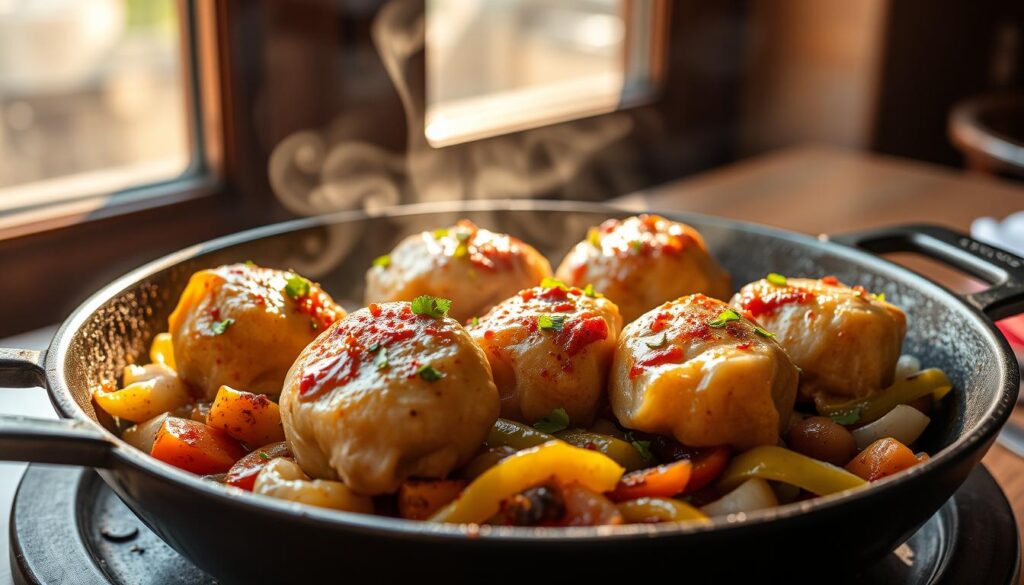In Madrid, I found a dish that changed how I see Spanish food. The mollejas a la madrileña recipe is more than food. It’s a way to connect with Madrid’s culture.
Exploring food, I discovered that the best dishes are often the ones you least expect. Mollejas, or sweetbreads, might seem scary at first. But in Madrid, they’re a sign of the city’s deep food history.
Making this Spanish dish is an art. It needs skill, patience, and respect for old cooking ways. From Madrid’s markets to family homes, mollejas carry a tradition that spans generations.
Key Takeaways
- Mollejas are a unique delicacy in traditional Madrid cuisine
- The recipe requires careful preparation and cooking techniques
- Sweetbreads represent an important part of Spanish culinary culture
- Authentic preparation involves specific cleaning and cooking methods
- The dish showcases the depth of Madrid’s gastronomic traditions
Introduction to Mollejas a la Madrileña
When I first tried mollejas, I was amazed by this hidden treasure of Spanish food. Sweetbreads are often ignored in traditional offal cooking. But they turn an unusual ingredient into a true culinary gem. Spanish recipes have always celebrated these tender pieces, showing that trying new foods can be both tasty and classy.
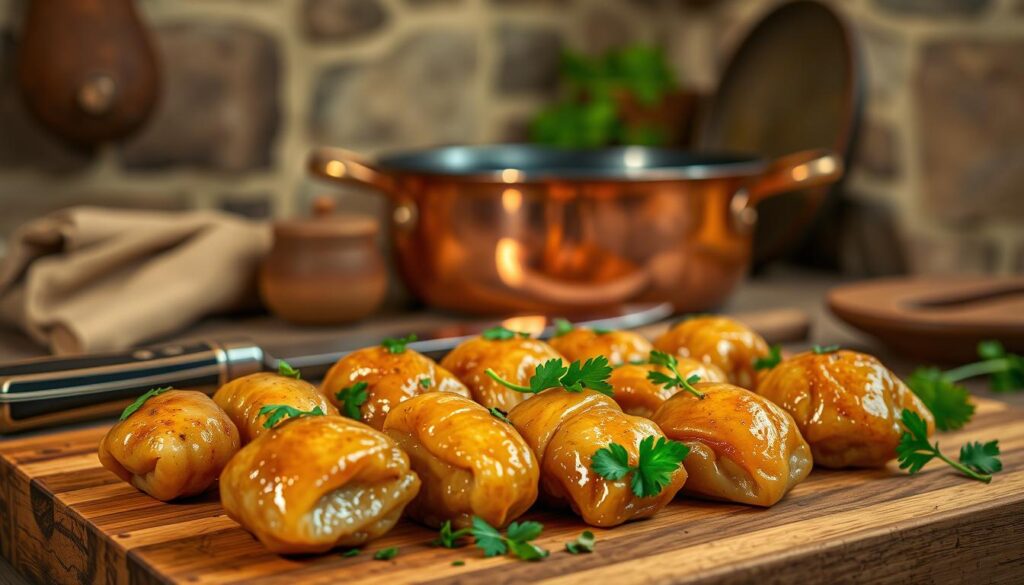
What Are Mollejas?
Mollejas, or sweetbreads, are not bread at all. They are soft, delicate organ meats from calves or lambs. Their creamy texture and mild taste make them a favorite in Spanish cooking. Sweetbreads offer a luxurious taste experience that changes how we see organ meats.
- Soft, tender texture
- Mild, subtle flavor profile
- Versatile cooking ingredient
The Cultural Significance in Spanish Cuisine
In Madrid’s lively food scene, mollejas are more than a dish. They show the Spanish idea of aprovechamiento, or making the most of things. Madrid’s tapas culture loves these creative sweetbread recipes. Chefs across Spain have made this simple offal into a gourmet delight, telling a story of tradition and creativity.
Every bite of mollejas is a testament to Spain’s rich culinary heritage and commitment to flavor.
Ingredients Needed for the Recipe
To make a true mollejas a la madrileña recipe, you need the right ingredients. These must capture the heart of Spanish cooking. I’ll show you what makes this dish special.
Fresh Mollejas: Selecting Quality Sweetbreads
Finding the best mollejas is key for a great meal. Look for veal sweetbreads that are fresh, pale, and plump. Here’s what to look for:
- Uniform light color without dark spots
- Smooth, unblemished surface
- Minimal visible fat
- Firm texture without excessive moisture
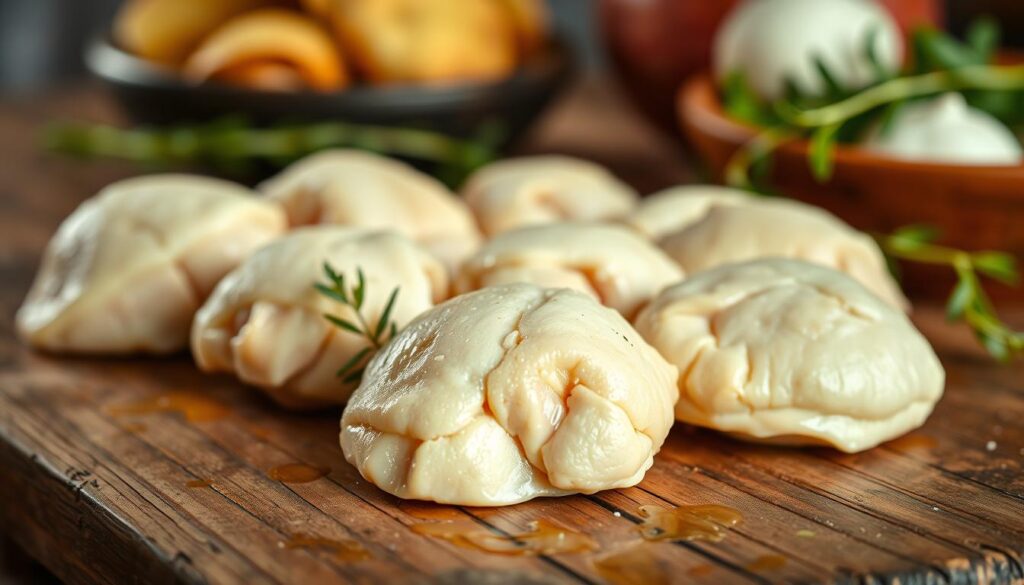
Essential Spices and Seasonings
The secret of a garlicky sauce is in its seasonings. My recipe uses saffron and other Spanish flavors to make the mollejas special.
- 2 fresh garlic cloves, minced
- Fresh parsley, finely chopped
- High-quality olive oil
- Pinch of saffron threads
- Sea salt and freshly ground black pepper
“The secret to an authentic mollejas a la madrileña is in the careful selection of ingredients and precise seasoning.”
With about 800 grams of veal sweetbreads and these ingredients, you’ll make a dish fit for a Spanish restaurant. It honors Madrid’s rich food culture.
Preparing Mollejas for Cooking
Offal cooking needs precision and care, like when working with sweetbreads like mollejas. I’ve learned that proper preparation is key to a tasty dish.
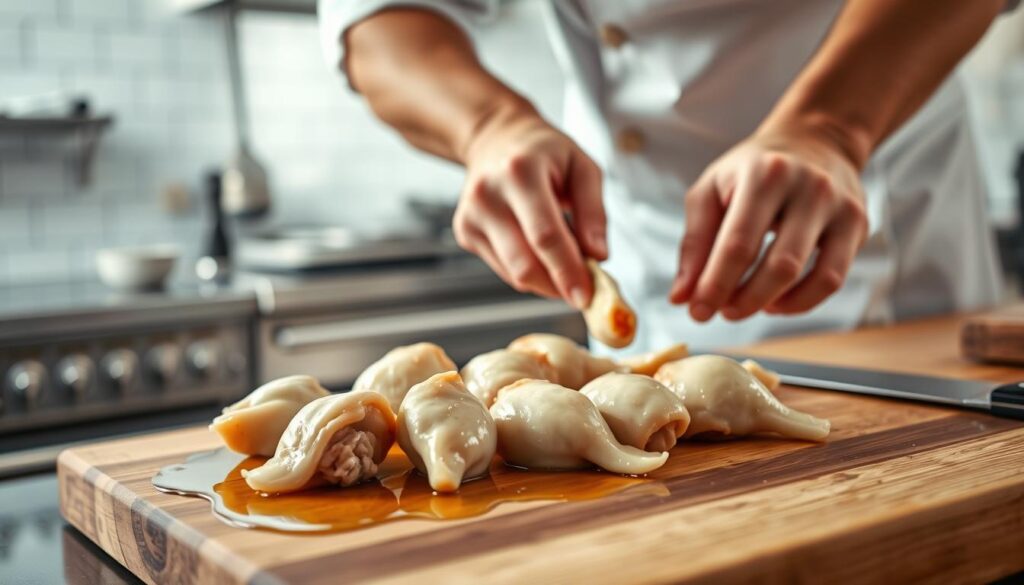
Before cooking mollejas, follow these important steps for the best taste and texture:
- Remove the outer membrane carefully
- Rinse thoroughly under cold water
- Trim excess fat meticulously
- Pat dry with clean paper towels
Cleaning Process for Perfect Sweetbreads
For a traditional Spanish dish, a detailed cleaning is recommended. Begin by soaking the sweetbreads in cold water with vinegar for 30 minutes. This step removes impurities and gets them ready for cooking.
Marination Techniques
Marinating is vital in offal cooking, making mollejas taste better. I mix:
| Ingredient | Purpose | Quantity |
|---|---|---|
| Olive oil | Tenderizing | 2 tablespoons |
| Garlic | Flavor enhancement | 3 cloves, minced |
| Paprika | Depth of flavor | 1 teaspoon |
| White wine | Tenderizing acid | 1/4 cup |
Let the mollejas marinate for at least 1 hour, but no more than 4 hours. This ensures they soak up flavor without losing their texture.
Cooking Method: Step-by-Step
Learning to fry with olive oil is key for a great mollejas a la madrileña recipe. Spanish cooking values the careful way of making sweetbreads into a dish that honors old traditions.
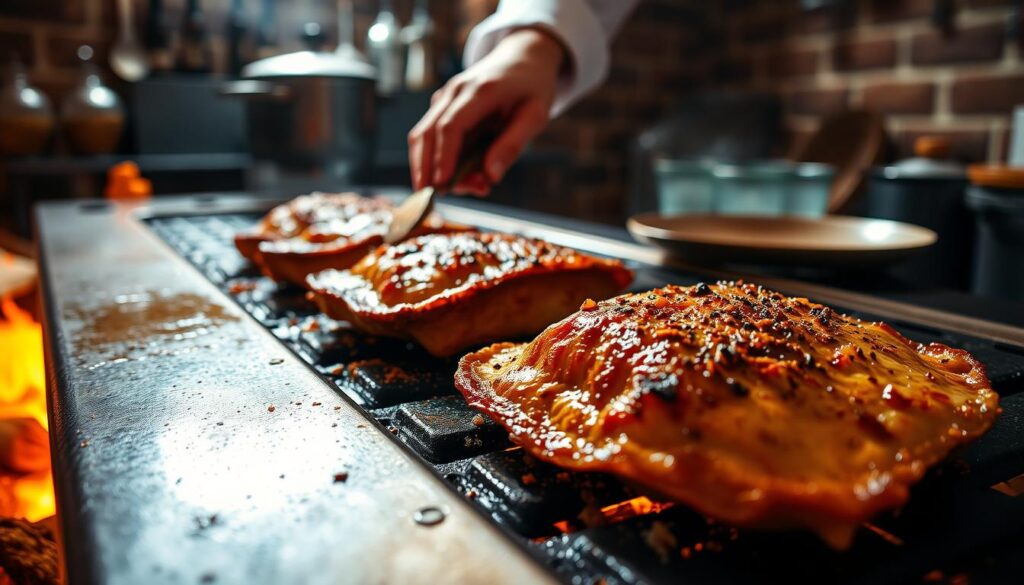
When searing mollejas, being precise is important. I’ll show you the main steps to get that perfect golden-brown look. This is what makes this Spanish delicacy special.
Searing Techniques for Perfect Mollejas
The cooking steps need your full attention. Here’s what to do:
- Clean sweetbreads well before cooking
- Pat dry with paper towels for better searing
- Season with salt and pepper
- Heat olive oil in a heavy skillet
Olive Oil: The Heart of Spanish Cooking
Use top-notch extra virgin olive oil for the best taste. The oil’s heat is important – it should be hot but not too hot.
| Cooking Stage | Time | Temperature |
|---|---|---|
| Initial Cleaning | 5 minutes | Boiling water |
| Searing | 2-3 minutes per side | Medium-high heat |
| Final Cooking | 4-5 minutes | 145°F (63°C) |
Pro tip: Look for a golden-brown crust to know the mollejas are done. Keep the heat steady and don’t overfill the pan.
Pairing Side Dishes
When making a traditional Madrid dish like mollejas, picking the right side dishes is key. My adventures in Spanish cuisine have shown me. The right sides can turn a simple tapas recipe into a meal to remember.
Traditional Spanish sides go great with mollejas, making the flavors balanced and true to the dish. Here are some classic pairings I suggest:
- Patatas bravas – crispy potatoes with spicy tomato sauce
- Pimientos de Padrón – small green peppers
- Pan con tomate – bread rubbed with fresh tomato
Modern Culinary Twists
I also enjoy trying new side dish combinations. A trip to Barcelona’s lively tapas scene made me think outside the box with mollejas pairings.
| Traditional Side | Modern Twist |
|---|---|
| Green salad | Quinoa and roasted vegetable salad |
| Plain bread | Herb-infused focaccia |
| Simple rice | Saffron-infused risotto |
For wine lovers, try pairing mollejas with a crisp Albariño or a light Tempranillo. These wines complement the rich flavors of this traditional Madrid dish.
Serving Suggestions
Presenting mollejas as a classic Spanish dish is an art. It turns this meal into a true tapas recipe experience. The goal is to celebrate Spanish dining traditions. Food here is more than just food; it’s a joy of flavors and social bonding.
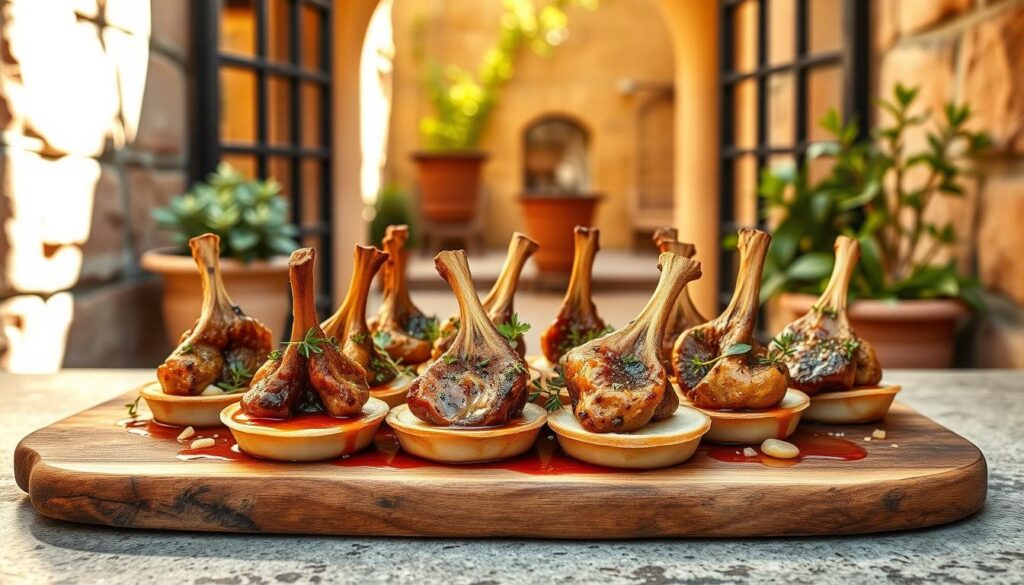
Presentation Ideas
Serve mollejas on a rustic ceramic plate for that traditional Spanish look. A bright lemon garnish adds a fresh citrusy touch. Add some fresh parsley or chives for color that matches the golden mollejas.
Perfect Accompaniments
- Crusty artisan bread for soaking up the delicious sauce
- A small glass of crisp Spanish white wine
- Marinated olives
- Roasted red peppers
The Mediterranean diet is all about sharing. Set up your mollejas as part of a larger tapas spread. This encourages conversation and connection.
| Accompaniment | Flavor Profile | Pairing Suggestion |
|---|---|---|
| Crusty Bread | Neutral, Absorbs Sauce | Serve Warm |
| Marinated Olives | Salty, Tangy | Contrast with Mollejas |
| Roasted Peppers | Sweet, Smoky | Complementary Side |
In Spanish cuisine, how you present your food matters as much as the taste. Serve your mollejas with love. Watch as your guests feel like they’re in Madrid’s lively streets!
Tips for Perfecting the Dish
Mastering offal cooking, like making mollejas a la madrileña, needs precision and care. Success comes from understanding the traditional Spanish dish’s nuances. My years of experience have shown me this.
Common Mistakes to Avoid
When cooking mollejas, chefs often make mistakes that ruin the dish. Here are the main errors to avoid:
- Overcooking the sweetbreads, making them tough and rubbery
- Skipping the initial cleaning of the offal
- Using low-quality ingredients
- Neglecting proper seasoning in the garlicky sauce
Expert Tips for Flavor Boost
To improve your mollejas, focus on detail and use professional techniques:
- Choose fresh, high-quality sweetbreads from a trusted butcher
- Marinate the meat in olive oil and garlic for better flavor
- Use a hot pan for a perfect sear
- Rest the meat before serving to keep it juicy
| Technique | Impact on Dish |
|---|---|
| Proper Cleaning | Removes impurities, improves texture |
| High Heat Searing | Creates delicious caramelization |
| Minimal Seasoning | Preserves natural sweetbread flavor |
The secret to a great sweetbread recipe is respecting the ingredients and keeping it simple. By following these tips, you’ll make a garlicky sauce that highlights the essence of Spanish offal cooking.
Wine Pairing Recommendations
Exploring the perfect wine for mollejas takes us into the heart of Spanish cuisine. This traditional Madrid dish needs a wine that matches its rich, delicate flavors. My journey through Spanish wine regions has shown me that the right wine can make this dish unforgettable.
When picking wines for mollejas, focus on local Spanish varieties. These wines show the depth of traditional Madrid culinary traditions. The goal is to find a wine that balances the intense flavor of sweetbreads.
Top Wine Selections for Mollejas
- Tempranillo: A robust red wine from Rioja that pairs beautifully with the rich texture of mollejas
- Albariño: A crisp white wine that offers a refreshing contrast to the dish’s intensity
- Garnacha: A medium-bodied red that complements the subtle flavors of sweetbreads
Regional Wine Recommendations
| Wine Region | Recommended Wine | Flavor Profile |
|---|---|---|
| Rioja | Tempranillo Reserva | Bold, oak-aged with dark fruit notes |
| Rías Baixas | Albariño | Crisp, mineral, with citrus undertones |
| Priorat | Garnacha Blend | Intense, full-bodied with spicy hints |
Try these wines to find the perfect match for mollejas. The right wine turns this dish into a memorable experience.
Storing Leftovers
After enjoying a delicious mollejas a la madrileña recipe, proper storage is key. Sweetbreads are delicate and need special care to keep their texture and taste.
- Cool the mollejas completely before refrigerating
- Store in an airtight container to prevent moisture loss
- Refrigerate within two hours of cooking
- Consume refrigerated leftovers within 1-2 days for optimal quality
Safe Refrigeration Techniques
To keep your Spanish culinary masterpiece fresh, place the mollejas in a shallow container. This helps them cool fast and stops bacteria from growing.
Reheating for Maximum Flavor
Reheating sweetbreads needs a gentle touch to keep their delicate texture. Here’s how to do it:
- Use a skillet on low-medium heat
- Add a small amount of olive oil
- Heat for 2-3 minutes, turning once
- Avoid overcooking to prevent toughening
Pro tip: Never reheat mollejas in the microwave, as this can destroy their delicate texture and unique flavor profile.
Conclusion and Final Thoughts
Exploring the mollejas a la madrileña recipe has been a joy. It’s a peek into Spanish cuisine’s heart. This dish is more than food; it connects us to Spain’s rich food culture.
Learning to make this recipe showed me the value of unique ingredients and techniques. Spanish cooking is all about passion, tradition, and strong flavors. Trying mollejas a la madrileña pushed me out of my comfort zone and introduced me to Madrid’s food heritage.
I urge home cooks to try new recipes. It’s a way to discover new flavors and techniques. Mollejas a la madrileña’s unique textures and flavors highlight Spanish cooking’s creativity and depth.
Food is a journey of discovery. Dishes like mollejas a la madrileña share stories. By cooking and sharing these dishes, we honor culinary traditions and celebrate global food diversity.
